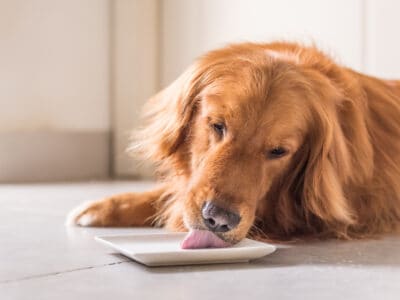How to Safely Treat and Clean Your Dog’s Wound
@media (min-width: 481px) {
.mobile-top-content {
display: none;
}
}
#mobileTopContentCTACarouselControls { overflow: hidden; text-overflow: ellipsis; white-space: nowrap; }
.mobile-top-content .more { color: #fff; }
.mobile-top-content a { color: #fff; text-decoration: underline; }
.mobile-top-content a:hover { color: #fff; text-decoration: underline; }
@media (max-width: 480px) {
.mobile-top-content {
background-color: #06a10b;
color: #fff;
text-align: center;
/*height: 60px;
padding-top:5px;*/
font-size:80%;
/* display: block; */
margin: 0px -30px;
}
}
Oh no! Your loyal companion pup has an injury! Fortunately, with the right tools and know-how, you can safely clean and treat your dog’s wound by applying first aid right there at home. The most important thing is to get the wound clean and dressed to prevent any unwanted items, like dirt and germs, from getting to it and causing more serious problems.
If the injury is severe or you aren’t sure what to do, call a vet or advice line to find out the best way to proceed. We also recommend following up with a vet even if you have effectively treated the injury to learn about the warning signs of infection or other serious complications.
1. iCare-Pet First Aid Kit with Thermometer
- Small and portable
- Multiple interior pockets
- Includes antiseptic wipes, tweezers, and sterile bandages
- First-aid guide included
- Small enough to take on a trip
- Comes with a thermometer
- Features multiple interior pockets
- Includes a helpful first aid guide
2. Adventure Medical Kits First Aid Kit For Dogs
- Portable and resealable
- Budget-friendly so you can have one in multiple locations
- Includes antiseptic wipes, gauze, and bandages in multiple sizes
- First-aid handbook guide included
- Waterproof and resealable
- Perfect for travel
- Affordable option
- Great to keep in the car
How To Clean Your Dog’s Wound
One of the most important steps to keeping your dog healthy after an injury is ensuring that the area is clean. Most injuries happen because the dog has contact with something else, often a branch, bush, or even another animal. All of this can introduce germs and dirt to the area once it is injured.
button.pulse {
transform: scale(1); animation: pulse 2s infinite;
box-shadow: 0 0 0 0 rgba(11, 247, 25, 1);
}
@keyframes pulse {
0% { transform: scale(0.90); box-shadow: 0 0 0 0 rgba(11, 247, 25, 0.5); }
60% { transform: scale(1); box-shadow: 0 0 0 15px rgba(11, 247, 25, 0); }
100% { transform: scale(0.90); box-shadow: 0 0 0 0 rgba(11, 247, 25, 0); }
}
Stop the Bleeding
Apply pressure to stop or reduce the bleeding. It may have stopped on its own already. Try to have your dog sit in one place so that their heart rate decreases. This can slow the bleeding and help you assess how bad the injury is.
If you are unable to stop the bleeding or are unsure, it is best to consult with a vet at this point. You can take photos or videos. Some vets work with apps to provide telehealth care remotely. They can help you determine if stitches or other care is needed.
Remove Larger Objects and Debris
If there are still twigs, leaves, or larger pieces of debris in or around the wound, remove them. Having a set of tweezers in your pet first aid kit is key for this step. While you can remove items with your hands in a pinch, tweezers are both more effective and sanitary. They also help you reduce the chances of making the wound larger or worse.
Wash with Water
Using clean water, wash the wound. If you have access to a squirt bottle, this is a great tool to get the area very clean. Pouring water over the wound is another good option. In a pinch, soak a clean cloth with water and wipe at the wound to get it clean.
Disinfect the Wound
Using a disinfecting wipe, clean the wound completely. Some dogs tolerate this better than others. The pressure on the hurt area and the feeling of the wipe can be uncomfortable. If your dog is scared or uncomfortable, ask another person to help comfort and hold them while you clean and disinfect the area. This is an important step that you should not skip, even if it is difficult for your dog. Getting rid of germs, bacteria, and dirt is important to make sure your dog does not get an infection.
How to Treat Your Dog’s Wound
There are a few great topical treatments that can help provide relief and ongoing antibiotic protection to your dog’s wounds. Apply these if your dog will allow you. If you apply them directly to the wound, make sure that the application method (q-tip, gauze, or gloved hands) is clean and sanitary. This helps reduce the risk of infection.
How to Dress Your Dog’s Wound
Once the wound is clean, apply a dressing or bandage to the wound. Just like with every other step, it’s important to maintain cleanliness while dressing the wound. A pet first aid kit is very important for keeping your dressings sanitary and accessible.
Dressings for dogs include individually wrapped sterile gauze pads, wrap bandages to secure the dressing, and sticky bandaids (sometimes). It is also helpful to have a small pair of medical scissors to cut down gauze, dressings, or bandages to the right size.
Should I Treat My Dog’s Wound at Home?
While many pet owners can clean and treat minor injuries and wounds, there are cases when it’s best to get the help of a professional. Here are some things to help you decide which path is right for your situation.
When to Clean and Treat the Wound
If the bleeding has stopped and your dog is acting normally, chances are you can clean and dress the wound at home. This is often the case for minor scratches and cuts, as well as some wounds requiring topical care.
Start by washing the wound to get a better idea of the damage. Wounds that are covered in dirt and debris may be hard to accurately assess until they are clean. Some dogs tolerate this better than others.
If your dog won’t let you near the wound or sit still long enough to let you wash it, that can be a problem even if the wound itself is not serious. Enlist the help of another person to hold or calm the dog while you wash it.
When to Get Vet Help
Uncontrolled bleeding and complex injuries are two scenarios that require veterinary care. Bind the wound as best you can to reduce the bleeding and take your pet to your local vet, if available, or an emergency vet. They will be able to accurately assess the wound and determine the best next steps.
If your dog is acting lethargic or unusual, take them to the vet even if the wound doesn’t look serious. They might be suffering from complications or other issues, such as a spider bite, that aren’t immediately obvious.
For dogs with a lot of anxiety, you may want to get professional help even for minor wounds. It’s important to get the wound cleaned thoroughly to prevent infection. If your dog won’t let you clean it, take them to the vet for a thorough rinse and assessment. They will likely bandage the wound as well and give you things to watch for as it heals.
Should I Wrap My Dog’s Open Wound?
Wrapping your dog’s open wound is a great step to making them more comfortable and safe. Properly cleaning and treating your dog’s wound can reduce their risk of infection and make the healing process comfortable for them. The key is to clean the wound first. We can’t emphasize this enough. The wound absolutely should be cleaned and disinfected before you wrap it.
To wrap your dog’s wound after you clean it, apply a sanitary piece of gauze to the open wound. You can use medical scissors to cut a piece of gauze to fit. It should extend beyond the edges of the wound slightly. If the bleeding has stopped, applying gauze will keep the area clean and sanitary.
For wounds that are still bleeding, you can apply a gauze pad to absorb any blood as it heals. Even wounds that have stopped bleeding may start to bleed again slightly as your dog moves around and the area is irritated. As long as the bleeding is slight and stops again quickly, this isn’t anything to worry about.
Continuous bleeding or bleeding that is bright red should be evaluated by a vet. Your dog can be at risk for serious complications if left untreated. You can apply a bandage to slow the bleeding and prevent the wound from getting worse or getting dirty. Even if it isn’t serious, your vet will still appreciate that you are being cautious. They can also give you signs to watch for as your dog’s wound heals.
How Long Will It Take for My Dog’s Wound To Heal?
Healing times can vary based on the severity and location of the wound. If it is an area that gets frequent use or movement, it may take longer to heal just because your dog frequently reopens or irritates the wound in their daily movement. Wrapping the wound and reapplying clean dressings periodically as it heals can make the process faster.
A medical dog cone may be necessary to keep your dog from scratching or licking the wound. As it gets better, the wound will likely be itchy. This means that it is healing. But it can also be uncomfortable and irritating to your dog. Many dogs bite at or lick wounds as their way of itching them. Because they itch, the healing process may take longer. Putting a medical cone around your dog’s neck can be a good way to make the injury less accessible. This can speed up healing.
How Do You Know If A Dog’s Wound Is Infected?
Infection is one of the most important things to watch for when your dog has an injury. To prevent infection, we recommend following up with your vet, even for injuries that you can treat yourself at home. They can evaluate the wound for signs of infection. Catching it early can save your dog discomfort and pain. Additionally, it can save you a lot of money treating a smaller problem rather than a larger, systemic infection.
Signs of local infection include:
- Redness at the injury site
- Swelling at the injury site
- Heat around the injury
- Pus or other liquid oozing from the wound
- Continued bleeding or restarted bleeding that does not stop
- Your dog doesn’t want to put weight on the injured limb
- Your dog is unusually protective of the injury site and it doesn’t improve with time
- Obvious pain or discomfort
Some dogs tolerate pain and discomfort better than others. If your dog starts to physically withdraw, this may be a sign that they are in pain. Some dogs go to a secluded area or space because they experience pain. Watch for signs of infection if this is the case.
Signs of systemic infection that should be evaluated by a vet right away:
- Shaking or tremors
- Fever
- Lethargic or low-energy behavior
- Confusion and disorientation
- Rapid or difficult breathing
- Vomiting
If your dog displays any of these symptoms after experiencing an injury, he should be evaluated right away. It may be a sign that they have a larger systemic infection. Your vet can take a look at the infection site and assess their other symptoms to see if they are related. Keeping the wound clean and dressed is one of the best ways to prevent these very serious infections.
Ready to discover the top 10 cutest dog breeds in the entire world?
How about the fastest dogs, the largest dogs and those that are — quite frankly — just the kindest dogs on the planet? Each day, AZ Animals sends out lists just like this to our thousands of email subscribers. And the best part? It’s FREE. Join today by entering your email below.
More from A-Z Animals
.more-snake-card-image { max-height:140px !important; }
@media (min-width: 481px) {
.mobile-top-content {
display: none;
}
}
#mobileTopContentCTACarouselControls { overflow: hidden; text-overflow: ellipsis; white-space: nowrap; }
.mobile-top-content .more { color: #fff; }
.mobile-top-content a { color: #fff; text-decoration: underline; }
.mobile-top-content a:hover { color: #fff; text-decoration: underline; }
@media (max-width: 480px) {
.mobile-top-content {
background-color: #06a10b;
color: #fff;
text-align: center;
/*height: 60px;
padding-top:5px;*/
font-size:80%;
/* display: block; */
margin: 0px -30px;
}
}
Oh no! Your loyal companion pup has an injury! Fortunately, with the right tools and know-how, you can safely clean and treat your dog’s wound by applying first aid right there at home. The most important thing is to get the wound clean and dressed to prevent any unwanted items, like dirt and germs, from getting to it and causing more serious problems.
If the injury is severe or you aren’t sure what to do, call a vet or advice line to find out the best way to proceed. We also recommend following up with a vet even if you have effectively treated the injury to learn about the warning signs of infection or other serious complications.
1. iCare-Pet First Aid Kit with Thermometer
- Small and portable
- Multiple interior pockets
- Includes antiseptic wipes, tweezers, and sterile bandages
- First-aid guide included
- Small enough to take on a trip
- Comes with a thermometer
- Features multiple interior pockets
- Includes a helpful first aid guide
2. Adventure Medical Kits First Aid Kit For Dogs
- Portable and resealable
- Budget-friendly so you can have one in multiple locations
- Includes antiseptic wipes, gauze, and bandages in multiple sizes
- First-aid handbook guide included
- Waterproof and resealable
- Perfect for travel
- Affordable option
- Great to keep in the car
How To Clean Your Dog’s Wound
One of the most important steps to keeping your dog healthy after an injury is ensuring that the area is clean. Most injuries happen because the dog has contact with something else, often a branch, bush, or even another animal. All of this can introduce germs and dirt to the area once it is injured.
button.pulse {
transform: scale(1); animation: pulse 2s infinite;
box-shadow: 0 0 0 0 rgba(11, 247, 25, 1);
}
@keyframes pulse {
0% { transform: scale(0.90); box-shadow: 0 0 0 0 rgba(11, 247, 25, 0.5); }
60% { transform: scale(1); box-shadow: 0 0 0 15px rgba(11, 247, 25, 0); }
100% { transform: scale(0.90); box-shadow: 0 0 0 0 rgba(11, 247, 25, 0); }
}
Stop the Bleeding
Apply pressure to stop or reduce the bleeding. It may have stopped on its own already. Try to have your dog sit in one place so that their heart rate decreases. This can slow the bleeding and help you assess how bad the injury is.
If you are unable to stop the bleeding or are unsure, it is best to consult with a vet at this point. You can take photos or videos. Some vets work with apps to provide telehealth care remotely. They can help you determine if stitches or other care is needed.
Remove Larger Objects and Debris
If there are still twigs, leaves, or larger pieces of debris in or around the wound, remove them. Having a set of tweezers in your pet first aid kit is key for this step. While you can remove items with your hands in a pinch, tweezers are both more effective and sanitary. They also help you reduce the chances of making the wound larger or worse.
Wash with Water
Using clean water, wash the wound. If you have access to a squirt bottle, this is a great tool to get the area very clean. Pouring water over the wound is another good option. In a pinch, soak a clean cloth with water and wipe at the wound to get it clean.
Disinfect the Wound
Using a disinfecting wipe, clean the wound completely. Some dogs tolerate this better than others. The pressure on the hurt area and the feeling of the wipe can be uncomfortable. If your dog is scared or uncomfortable, ask another person to help comfort and hold them while you clean and disinfect the area. This is an important step that you should not skip, even if it is difficult for your dog. Getting rid of germs, bacteria, and dirt is important to make sure your dog does not get an infection.
How to Treat Your Dog’s Wound
There are a few great topical treatments that can help provide relief and ongoing antibiotic protection to your dog’s wounds. Apply these if your dog will allow you. If you apply them directly to the wound, make sure that the application method (q-tip, gauze, or gloved hands) is clean and sanitary. This helps reduce the risk of infection.
How to Dress Your Dog’s Wound
Once the wound is clean, apply a dressing or bandage to the wound. Just like with every other step, it’s important to maintain cleanliness while dressing the wound. A pet first aid kit is very important for keeping your dressings sanitary and accessible.
Dressings for dogs include individually wrapped sterile gauze pads, wrap bandages to secure the dressing, and sticky bandaids (sometimes). It is also helpful to have a small pair of medical scissors to cut down gauze, dressings, or bandages to the right size.
Should I Treat My Dog’s Wound at Home?
While many pet owners can clean and treat minor injuries and wounds, there are cases when it’s best to get the help of a professional. Here are some things to help you decide which path is right for your situation.
When to Clean and Treat the Wound
If the bleeding has stopped and your dog is acting normally, chances are you can clean and dress the wound at home. This is often the case for minor scratches and cuts, as well as some wounds requiring topical care.
Start by washing the wound to get a better idea of the damage. Wounds that are covered in dirt and debris may be hard to accurately assess until they are clean. Some dogs tolerate this better than others.
If your dog won’t let you near the wound or sit still long enough to let you wash it, that can be a problem even if the wound itself is not serious. Enlist the help of another person to hold or calm the dog while you wash it.
When to Get Vet Help
Uncontrolled bleeding and complex injuries are two scenarios that require veterinary care. Bind the wound as best you can to reduce the bleeding and take your pet to your local vet, if available, or an emergency vet. They will be able to accurately assess the wound and determine the best next steps.
If your dog is acting lethargic or unusual, take them to the vet even if the wound doesn’t look serious. They might be suffering from complications or other issues, such as a spider bite, that aren’t immediately obvious.
For dogs with a lot of anxiety, you may want to get professional help even for minor wounds. It’s important to get the wound cleaned thoroughly to prevent infection. If your dog won’t let you clean it, take them to the vet for a thorough rinse and assessment. They will likely bandage the wound as well and give you things to watch for as it heals.
Should I Wrap My Dog’s Open Wound?
Wrapping your dog’s open wound is a great step to making them more comfortable and safe. Properly cleaning and treating your dog’s wound can reduce their risk of infection and make the healing process comfortable for them. The key is to clean the wound first. We can’t emphasize this enough. The wound absolutely should be cleaned and disinfected before you wrap it.
To wrap your dog’s wound after you clean it, apply a sanitary piece of gauze to the open wound. You can use medical scissors to cut a piece of gauze to fit. It should extend beyond the edges of the wound slightly. If the bleeding has stopped, applying gauze will keep the area clean and sanitary.
For wounds that are still bleeding, you can apply a gauze pad to absorb any blood as it heals. Even wounds that have stopped bleeding may start to bleed again slightly as your dog moves around and the area is irritated. As long as the bleeding is slight and stops again quickly, this isn’t anything to worry about.
Continuous bleeding or bleeding that is bright red should be evaluated by a vet. Your dog can be at risk for serious complications if left untreated. You can apply a bandage to slow the bleeding and prevent the wound from getting worse or getting dirty. Even if it isn’t serious, your vet will still appreciate that you are being cautious. They can also give you signs to watch for as your dog’s wound heals.
How Long Will It Take for My Dog’s Wound To Heal?
Healing times can vary based on the severity and location of the wound. If it is an area that gets frequent use or movement, it may take longer to heal just because your dog frequently reopens or irritates the wound in their daily movement. Wrapping the wound and reapplying clean dressings periodically as it heals can make the process faster.
A medical dog cone may be necessary to keep your dog from scratching or licking the wound. As it gets better, the wound will likely be itchy. This means that it is healing. But it can also be uncomfortable and irritating to your dog. Many dogs bite at or lick wounds as their way of itching them. Because they itch, the healing process may take longer. Putting a medical cone around your dog’s neck can be a good way to make the injury less accessible. This can speed up healing.
How Do You Know If A Dog’s Wound Is Infected?
Infection is one of the most important things to watch for when your dog has an injury. To prevent infection, we recommend following up with your vet, even for injuries that you can treat yourself at home. They can evaluate the wound for signs of infection. Catching it early can save your dog discomfort and pain. Additionally, it can save you a lot of money treating a smaller problem rather than a larger, systemic infection.
Signs of local infection include:
- Redness at the injury site
- Swelling at the injury site
- Heat around the injury
- Pus or other liquid oozing from the wound
- Continued bleeding or restarted bleeding that does not stop
- Your dog doesn’t want to put weight on the injured limb
- Your dog is unusually protective of the injury site and it doesn’t improve with time
- Obvious pain or discomfort
Some dogs tolerate pain and discomfort better than others. If your dog starts to physically withdraw, this may be a sign that they are in pain. Some dogs go to a secluded area or space because they experience pain. Watch for signs of infection if this is the case.
Signs of systemic infection that should be evaluated by a vet right away:
- Shaking or tremors
- Fever
- Lethargic or low-energy behavior
- Confusion and disorientation
- Rapid or difficult breathing
- Vomiting
If your dog displays any of these symptoms after experiencing an injury, he should be evaluated right away. It may be a sign that they have a larger systemic infection. Your vet can take a look at the infection site and assess their other symptoms to see if they are related. Keeping the wound clean and dressed is one of the best ways to prevent these very serious infections.
Ready to discover the top 10 cutest dog breeds in the entire world?
How about the fastest dogs, the largest dogs and those that are — quite frankly — just the kindest dogs on the planet? Each day, AZ Animals sends out lists just like this to our thousands of email subscribers. And the best part? It’s FREE. Join today by entering your email below.
















